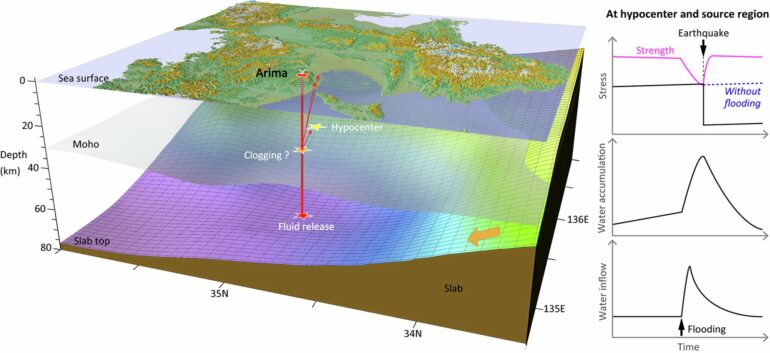Researchers at University of Tsukuba have shown that the 1995 Kobe (Hyogo-ken Nanbu) earthquake, which struck southern Hyogo Prefecture, may have been triggered by deep underground flooding beneath Arima Hot Springs. By analyzing the stable isotope ratios of hydrogen and oxygen as well as chloride ions in Arima hot spring water over several decades, the researchers have uncovered a likely connection between the earthquake and water originating from the subducting Philippine Sea Plate.
Hot springs frequently contain water that originates from rocks within the Earth’s crust. This can be confirmed through isotopic analysis. Arima Hot Springs, located in Kobe, Hyogo Prefecture, Japan, exhibit unique characteristics, including salinity that is more than twice that of seawater, indicating that their water likely originates from the Philippine Sea Plate. However, direct evidence supporting this connection is lacking.
In a study appearing in Communications Earth & Environment, researchers confirmed that the isotopic ratios of plate-derived water beneath Arima Hot Springs, as predicted by a numerical model, agreed with those of nonmeteoric water components found in the actual spring water. Additionally, they observed that the proportion of plate-derived water decreased exponentially after the development of deep well drilling in the 1940s but saw a temporary increase around 1995.
Notably, before the 1995 Kobe (Hyogo-ken Nanbu) earthquake in southern Hyogo Prefecture, such an increase was observed in three of the seven springs studied, and this phenomenon is similar to the increased concentrations of chloride ions and radon in groundwater, which have been reported as precursors to the earthquake.
The estimated volume of plate-derived water during this period exceeded 100,000 cubic meters, potentially weakening the fault and triggering the 1995 Kobe earthquake.
Moreover, this phenomenon is not unique to Arima. The Matsushiro earthquake swarm (1965–67) also displayed similar characteristics. Researchers have found that a substantial amount of water in Matsushiro hot springs originates from the Philippine Sea Plate.
Therefore, monitoring such hot spring water could offer valuable insights for earthquake prediction.
More information:
Tsutomu Yamanaka et al, Hot springs reflect the flooding of slab-derived water as a trigger of earthquakes, Communications Earth & Environment (2024). DOI: 10.1038/s43247-024-01606-1
Provided by
University of Tsukuba
Citation:
Deep underground flooding beneath hot springs: A potential trigger for the 1995 Kobe earthquake (2024, September 13)



